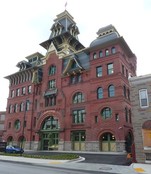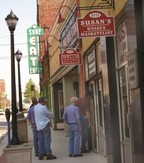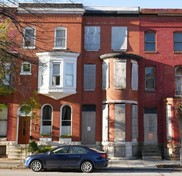Competitive Commercial Tax Credits
The Maryland Historic Revitalization Tax Credit Program is accepting FY22 applications for competitive commercial projects. Owners of income-producing properties have the opportunity to earn a state income tax credit (capped at $3 million) equal to 20 percent of eligible expenses for substantial rehabilitation projects. Applications are due by August 31, 2021. To learn more, please visit our web page.
|
|
 |
Small Commercial Tax Credits
As of June 1, the Maryland Historic Revitalization Tax Credit Program is accepting applications for small commercial projects (projects of $500,000 or less) on a first-come, first-served basis until the program cap is reached. To learn more, please visit our web page.
|
|
 |
By Elizabeth Hughes, MHT Director
Growing up in Salisbury, summers always included weekday trips to the beach with my mother. Armed with my trusty yellow and blue inflatable raft, I would spend the day riding Ocean City waves, getting a bright red sunburn, and eating peanut butter and jelly sandwiches crunchy with sand. The drive home sitting in a gritty swimsuit was always a drag – improved only by dipping my hand into the Fishers’ popcorn box that grew lighter and lighter with each passing mile.
I didn’t realize until recently that my mom, who grew up in Baltimore, also had summer beach adventures when she was a kid. But her beach wasn’t in Ocean City – it was in Betterton, located on the Chesapeake Bay in Kent County, Maryland.
Vintage postcard of Betterton Beach and the Chesapeake House hotel
Betterton, once known as “Maryland’s Foremost Bayside Resort,” developed its reputation as an attractive tourist destination as early as the 1880s when steamboats brought visitors to the early “Chesapeake House” hotel. The subsequent construction of the Hotel Rigbie, the Bayside Inn, and the Hotel Betterton provided gracious lodging and meals featuring the Eastern Shore’s freshest local seafood and abundant produce.
The Betterton National Register Historic District nomination describes a thriving town during the first two decades of the 20th century: “Orchestras played in the ballrooms of the hotels and the watermen began running daily fishing trips for the tourists. At least eight steamers stopped at Betterton daily…. Steamboats such as the Susquehanna, S.S.Belle, and the Bay Belle brought thousands of visitors to the town that only 200-300 people called home.” The resort, like many on the Chesapeake Bay, was segregated, making these pleasures off-limits to African Americans until the 1960s.
Vintage postcard of the S.S. Bay Belle
My mother’s summer trips to Betterton in the 1940s were likely on the Bay Belle, a 206’ long steamship of the Wilson Line out of Wilmington that could carry up to 2,400 people on the 2 ½ hour trip from Baltimore. Her day would begin with a ride on the streetcar from her home in Woodlawn to the Baltimore Harbor. There, at Pier 5, she and her mom and the Dorsey kids (Butch and Mary Lou) would board the boat to Betterton. After a day at the beach, including a ride on the “racer dip,” they would return home.
Betterton’s beachfront is significantly changed today. The town’s tourism industry began stalling in the 1930s as a result of the Great Depression. As steamboat traffic declined, so did the crowds of visitors that came to swim in the town’s nettle-free waters. Over time, hotels and boarding houses were either burned, demolished or converted for other uses. While dance halls, bowling alleys and amusement arcades have all faded away, Betterton welcomes everyone, and its beautiful 300 foot bayside beach remains a relaxing summer day trip. All you need is a raft, some peanut butter and jelly sandwiches, and – unless you plan to join me at the dermatologist’s office – sunblock.
Learn more about Betterton, including restaurants (Barbara’s on the Bay and Marzella’s by the Bay) and upcoming special events like the June 27th Bay to Bay Bicycle Ride by visiting Kent County Tourism.
Baltimore City Grants Available
The Baltimore City Historic Preservation Fund is accepting applications through August 6! The fund is supported by the Baltimore Community Foundation and administered by Preservation Maryland, in partnership with the Maryland Historical Trust, Baltimore Heritage, and the Baltimore City Commission for Historical and Architectural Preservation. The fund provides direct assistance for capital and non-capital activities that advance efforts to preserve historically significant properties in the City of Baltimore.
|
|
 |

OUR HISTORY, OUR HERITAGE: BLOG ROUND-UP
|